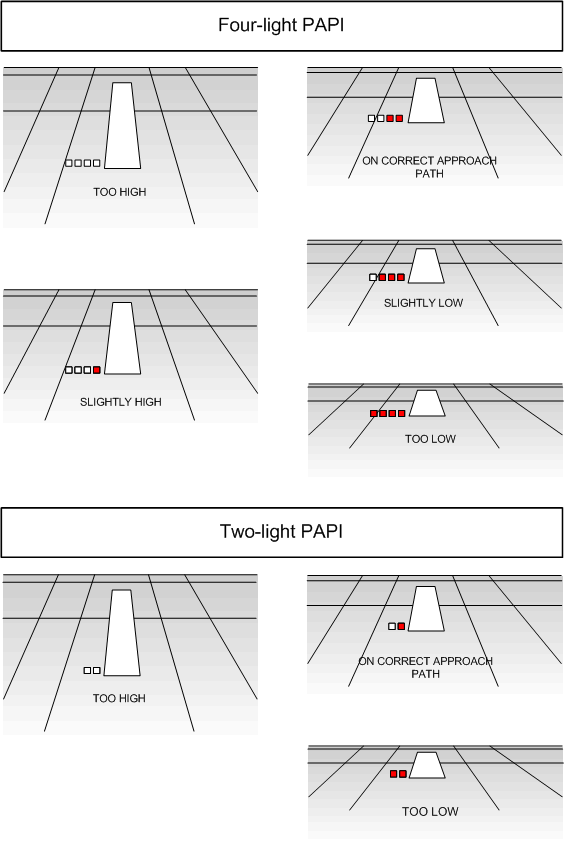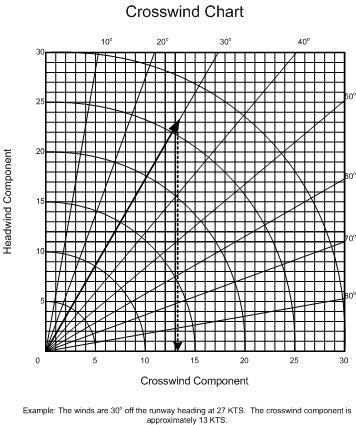Landing
Landing Errors
Wheelbarrowing—danger in tricycle gear aeroplanes, caused by pilot placing too much weight on nose gear with forward control pressure; during takeoffs, this occurs when the pilot attempts to excessively hold the aircraft on the ground; during landings, it occurs commonly in combination with full flaps and excessive speed—again excessive attempts are made to hold the aircraft on the ground, and braking power is reduced as the main gear lacks weight. Solution: Go around.
Balloons and Bounces—excessive back pressure during the flare for landing; the aircraft is caught gaining height above the runway at near-stall speeds—if the aircraft is then dropped onto the runway a bounce will be produced. Solution: Go around or, if safe, add power to re-establish the flare.
Porpoising—aircraft is bounced back and forth on the nose and main gear, caused by improper landing attitude and excessive speed. Smoothly regain the correct landing attitude and add power to become airborne again—go around.
Landing Illusions
Rain on the windshield causes a distortion—refraction—that makes terrain appear lower than it actually is—a hilltop ½ mile away may appear 200’ lower than it actually is.
Also, landing on a upslope runway presents a similar illusion—that you are higher than what you actually are. Here is a summary of the landing illusions that pilots can experience:
|
Situation |
Illusion |
Outcome |
|
Runway narrower than usual |
Too high |
Tendency to flare late |
|
Runway wider than usual |
Too low |
Tendency to flare early |
|
Runway slopes up |
Too high |
Tendency to make low approach |
|
Runway slopes down |
Too low |
Tendency to make high approach |
|
Terrain before runway is higher |
Too low |
Tendency to make high approach |
|
No lights before runway at night (black-hole) |
Too high |
Tendency to make low approach |
|
Air very clear at night |
Closer to airport than actual fact |
Tendency to descend too early |
|
Smoggy or hazy air |
Farther from airport than actual fact |
Tendency to descend too late |
Precision Approach Path Indicators (PAPI)
PAPIs are commonly found at airports, and they provide the pilot with precise visual feedback with respect to the position of the aircraft on glidepath prescribed for the airport. They are especially useful for night approaches, where the ever-present risk is for the pilot to allow the aircraft to inadvertently descend below the glide path into the “black hole” that sometimes exists below the final approach path when there are little or no ground lights.

Two types of PAPIs are commonly used—a two-light presentation, and a four-light presentation (aboved). “On-glide” indications are provided when the PAPI lights are evenly split—one-half are red, and the other half is white (“red and white, you’re all right”). An all-white PAPI display indicates the aircraft is high on the glidepath, while all-red display indicates the aircraft is low (“red and red . . you’re dead”).
Landing Rules of Thumb
As a rule, landings airspeeds should be 1.3 times the aircraft’s power-off stalling speed (calibrated) in a landing configuration (Vso)—i.e., full flaps, and gear down (if applicable). The airspeed should only be flown after all manoeuvring for landing is completed—thus it only applies to “short final” phase of landing, beginning at the midpoint of the final approach leg.
Note that this rule does not apply to all aircraft; as the landing speeds in some aircraft may be prescribed in Pilot Operating Handbook without variation.
Note additionally that the 1.3 Vso rule applies to stalling speeds for the actual weight of the aircraft, as per the stalling speeds found the aircraft’s Pilot Operating Handbook. Without this information, however, weight adjustments to the final approach airspeed can be made: reduce Vso by one-half the percentage to which the aircraft is loaded below the gross weight. For example, if an aircraft has a Vso of 50 KTS, the short final is normally flown at 65 KTS calibrated. If, however, the maximum gross weight is 2100 lbs., and its actual weight is 1800 lbs., its approach speed should be further reduced by approximately 7% (one-half of 14.29%)—instead of 65 KTS, the approach should therefore be flown at 61 KTS (60.45 KTS to be precise).
When landing in gusting conditions, the final approach speed should be increased by one-half the gust velocity.
Crosswind Landing Limitations
Approximately 10% of all light Canadian aircraft accidents are attributed to pilots’ inability to control the aircraft during crosswind landings.
Using crosswind chart (found in the Canada Flight Supplement), winds anticipated during a landing can be broken down into two portions: the headwind component, and the crosswind component. The crosswind component is used to predict aircraft performance. Students should be readily familiar with the use of these graphs.

As a rule, North American aircraft are designed to withstand a maximum crosswind equal to 20% of the aircraft stall speed; this figure, however, is conservative as a skilled and proficient pilot is typically able to land with crosswind components equal to 30% of the stall speed.
Students often error with respect to the proper conversion of winds reported in “magnetic” degrees, and winds reported in “true” degrees. Just remember that only the winds communicated by a control tower or by ATIS (recorded airport information transmitted on a radio frequency) is in “magnetic” degrees; all written weather reports regarding winds, including airport terminal forecasts, describe the winds in “true” degrees, and must therefore be converted to “magnetic”. Remember that a runway heading is based on “magnetic” degrees in the Southern Domestic Airspace.
.jpg)

